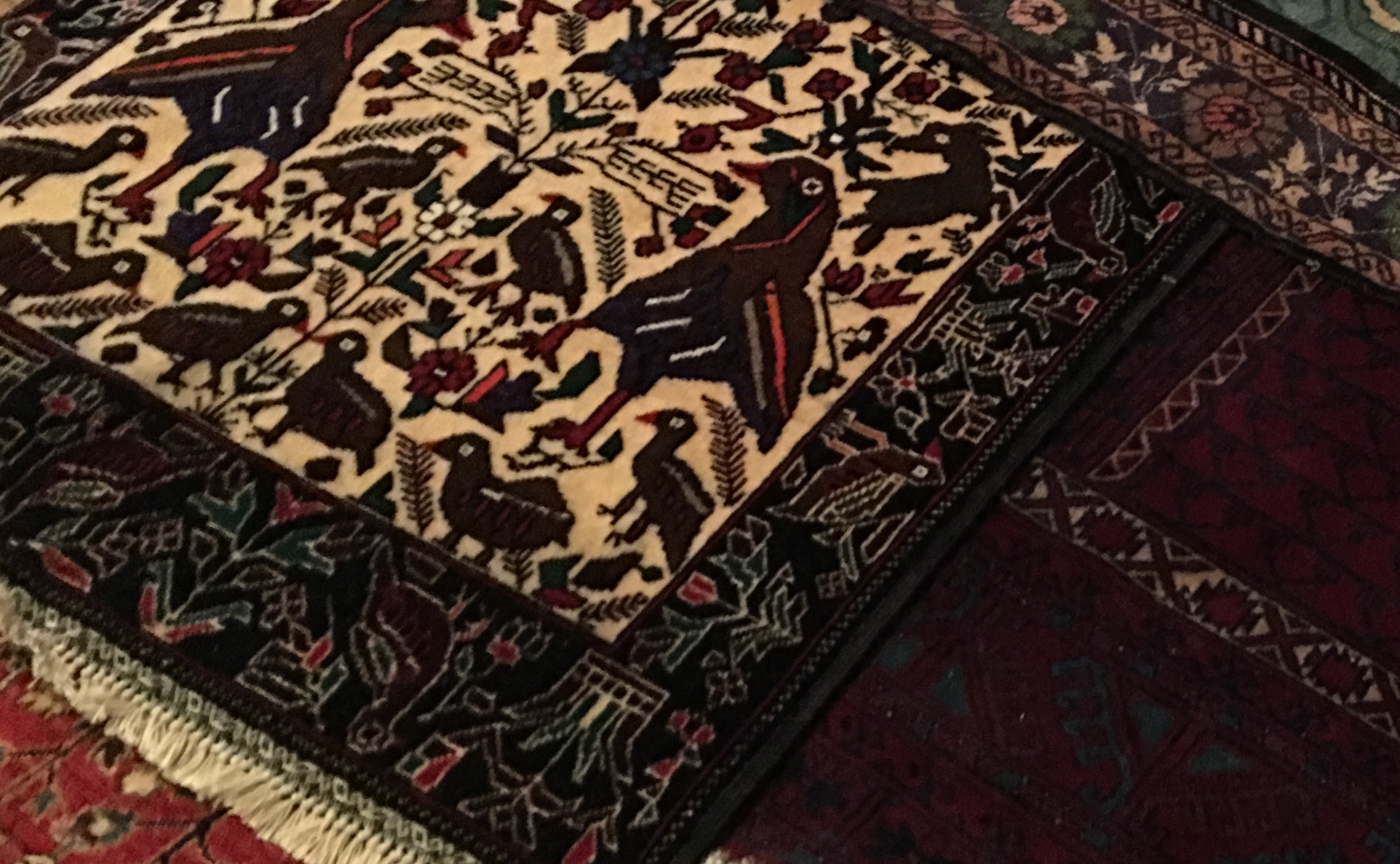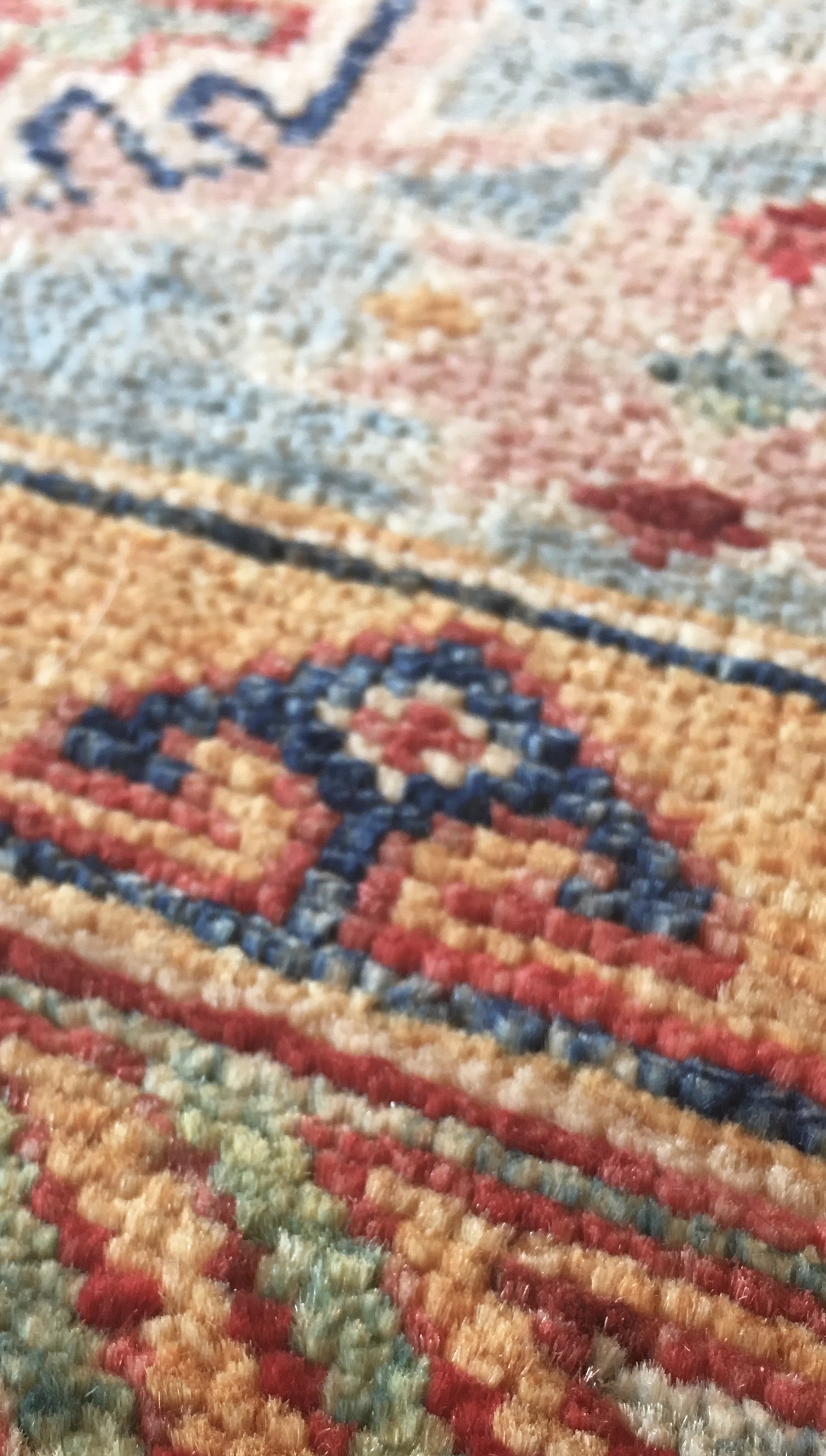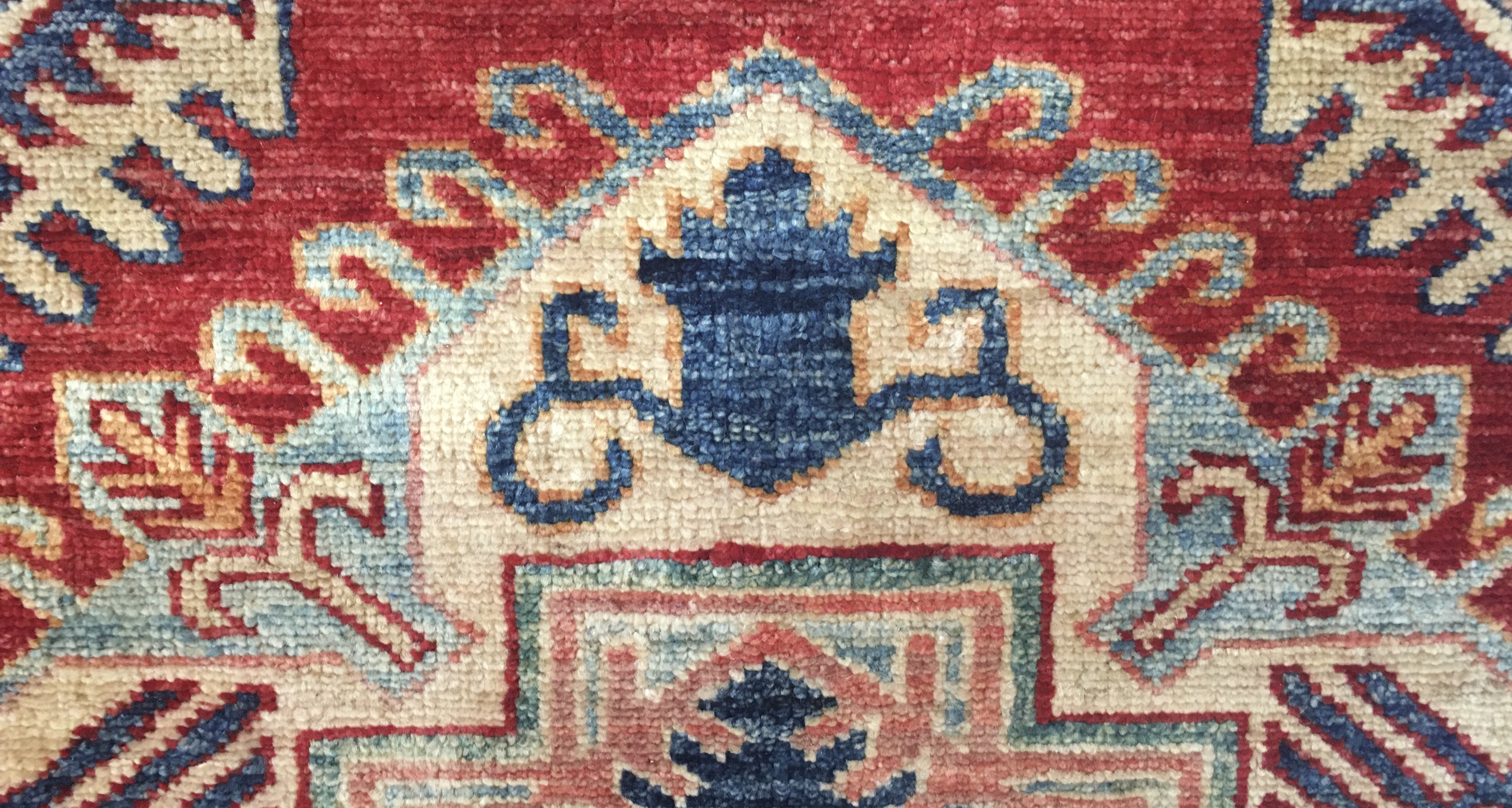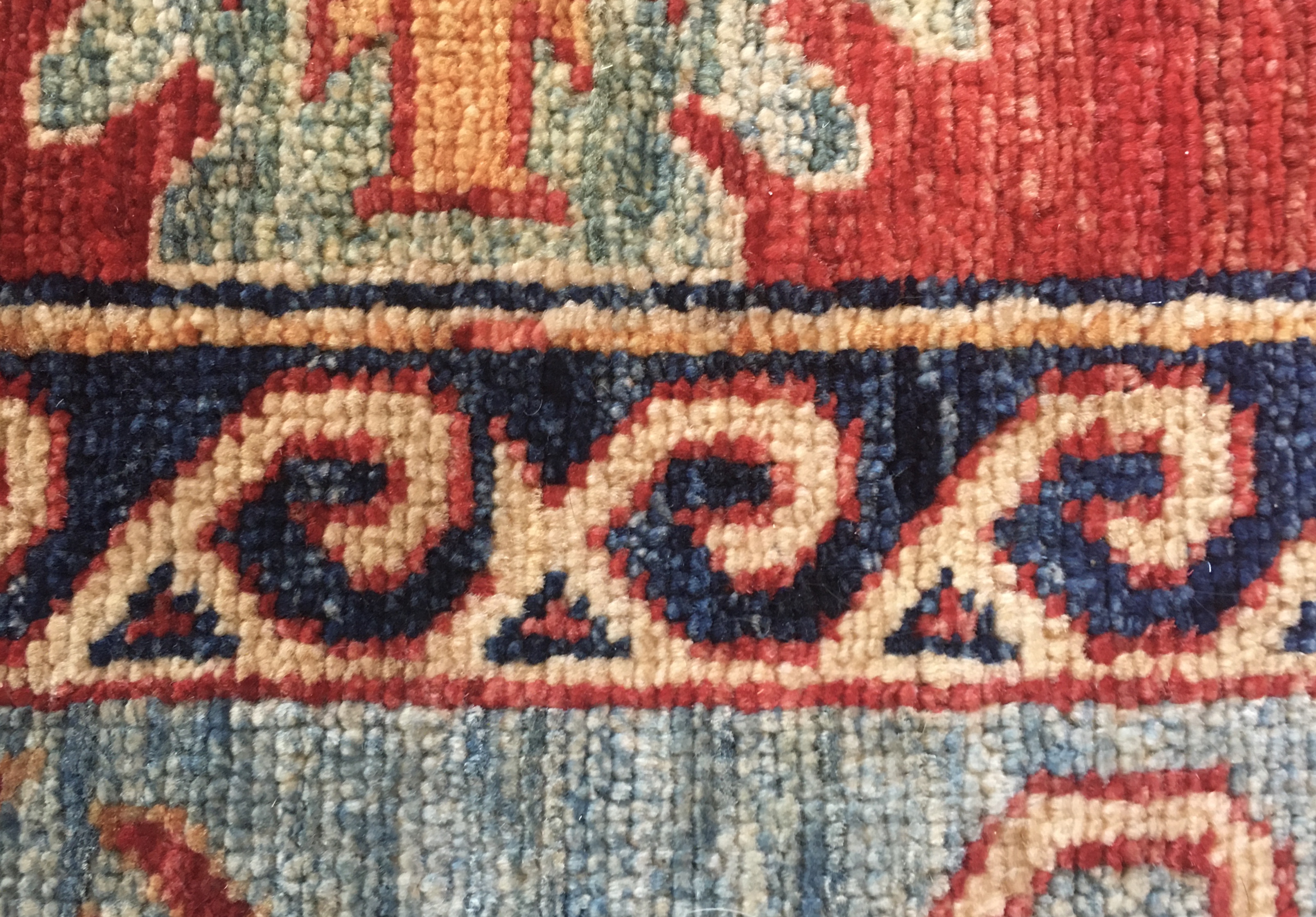
Check here for more information on the homepage rugs.
Nancy Small with Riyaz Bhat



The previous sections of this webtext have applied a framework for reading a textile as a means of learning more about the person who made it. Although the framework is designed to apply to a wide range of material items, its possibilities have been tested by applying it across significant differences of time, location, culture, and identity. A carrier of memory and a powerful rhetorical expression, the Shirin rug is a complicated set of encodings that, when read with a purposeful recentering, offer a re-visualization as Krystin Gollihue and Mai Nou Xiong-Gum (2020) contended, but this time of the textile's maker. Deep study of sources and practices associated with the making process, as well as extended consultation with an expert can allow for re-reading the Shirin rug as an act of critical imagination (Royster & Kirsch, 2012). That reading produced information about the weaver's choices and agency according to genre, content, setting, plot, stylistics, and symbols. Those observations occurred at the intersection of the artifact and its creator, as the rug contained evidence within its knots. If, however, this reading might result in an emergent story of the weaver, then one additional step remains.
That final step interweaves the framework elements into a memoir-style portrait of the Shirin rug's maker. By tacking out to view the narrative–rhetorical features of the rug holistically, a composite counterstory emerges. Sociologist Rebecca Willis (2019) proposed the creation of "composite narratives" (a synthesis of multiple interviewee responses into a singular narrative) as a means of protecting participant anonymity in research regarding sensitive topics. Rather than a composite of interviews, the composite my framework develops is a combination of secondary research, primary research, and observations resulting from the framework's reading. Motivated by the continued silencing of marginalized voices, Aja Y. Martinez (2020) has developed a "counterstory" approach informed by critical race theory as a similarly compelling methodology for rhetoric and writing studies. Counterstory also synthesizes multiple sources of information in order to "expose, analyze, and challenge majoritarian stories of racialized privilege and . . . to strengthen traditions of social, political, and cultural survival, resistance, and justice" (p. 26). Here, that majoritarian privilege manifests in those authors and systems that erase the woman weavers in favor of viewing the products of their craft (the rugs) as disembodied commodity.
Merging the composite and counterstory approaches, Martinez (2020) cited Daniella Ann Cook and Adrienne D. Dixson in outlining three contributions of "composite counterstorytelling" in qualitative work: it creates "empirical space" for marginalized populations, it "requires descriptions of rich, robust contexts" to "focus on larger issues" beyond the individual, and it—as a story-based approach—emphasizes "accessib[ility] beyond academic audiences" (p. 24). The framework, sample reading, and emergent narrative demonstrated here are all crafted with these goals in mind. The framework itself engages material items re-presented as powerful locations of silenced stories, but depending upon the artifact being read, demands substantive contextualization beyond the individual artifact and its maker (thus the section on erasure and the section on my rationale). The story-based approach here uses that deeper secondary research, as well as Riyaz's expertise, in service of recovering the weaver herself as a re-storied agent. Centering her in a story of critical imagination helps readers visualize her as a subject/agent and resists her being subsumed only in academic study of history, culture, manufacturing, and so forth. She is accessible by being present through her work.
That said, as a white scholar who acknowledges the complexities of race and identity in taking up these projects and who seeks to amplify (rather than appropriate) these scholars' processes, I believe that composite counterstory as a method and methodology offers a compelling act of resistance in a re-reading of Central Asian rugs because it applies material evidence as a "challenge to 'majoritarian' stories or 'master narratives' of white privilege" (Martinez, 2020, p. 3). I honor and respect Martinez's work as well as the growing field of Indigenous methods and methodologies grounded in the power of story (e.g., Archibald, Lee-Morgan, & De Santolo, 2019; Wilson, 2008; Windchief & San Pedro, 2019). I also realize that engaging these scholars' work here extends their methodologies to a multidimensional cross-cultural context that they may or may not have intended.
As an effort to speak back to the capitalist forces diminishing the weaver of the Shirin rug, here is one potential counterstory emerging out of the research, framework, and subsequent re-reading presented in the previous webtext sections. Although a potentially controversial choice, I have named the weaver Maryam. My decision is based on Riyaz's expert opinion that weavers are almost always women and on my desire to avoid the generic connotations of words such as "the weaver." The Shirin weaver was a person located in a gendered system, and names personalize narratives. In the narrative, please note particularly the intentional centering of agency through active verbs and amplification of skills previously erased in the master narrative. Relocating the subject, who is so often erased due to gendered systems and market commodification, and putting agency back in her hands are my driving motivations.
Following in the footsteps of her mother and grandmothers, Maryam learned to carefully make the knots and work the beater. After demonstrating notable patience and care for someone so young, and by acquiring experience with the traditional designs, she progressed into her role as weaver. She studied construction of the looms, carefully adjusting the vertical threads of the warp, ensuring they were firmly secured and of equal length to produce a sturdy shape. She honed her skills at tying the knots with consistent tension and trimming the rows to a perfectly even pile. She and her sisters became adept at choosing the roots, stems, and flowers of local plants to create dyes, practicing the process of soaking and heating the color baths to consistently produce both the traditional hues of the common rugs, and then later on, more nuanced palettes. She developed an aptitude for color, observing what complemented and clashed, and how to create depth and shading as the rug slowly emerged, line by line, from bottom to top.
Like everyone else in her family, Maryam contributed to the work of daily life. Along with her sisters and nieces (and perhaps her daughters), she kept the family tents warm and functional through the rugs and other textiles she created alone and in collaboration with familial weaving teams. During the long, dark evenings of the harsh winters, she listened to—and perhaps herself told—traditional stories of Persia and the Caucuses. On occasional visits into Herat, the architecture, tile work, textiles, and other aesthetic details caught her eye as a designer and inspired her to set up a loom for herself. It was a common size, small enough for one person to complete, so she stretched the warp and gathered the wool she had helped to spin and dye.
For her design, she chose the love story of Shirin and Farhad. Her choice of content was a bit rebellious, differing from the designs her family was known for using in their tents and relying on for bartering trade in the spring. Although she made slow progress, Maryam did not finish the rug in a season and so carefully packed it up for the family's movement to a new location. After she completed the rug, it adorned the wall of her tent, reminding her of the beautiful stories.
Applying the framework and reading the rug as a material memoir produces threads of evidence and observation to weave into this composite, a different story purposefully foregrounding the weaver as an agent who has developed multiple literacies ("learned," "demonstrating," "studied," "hone her skills," "became adept," etc.). You may have used the evidence from the re-reading to form your own story, one different from mine. Either way, the weaver (as Maryam) emerges as much more than eyes peeking out from behind a tent door, living more than a joyless life of domestic labor (see Warp & Weft). Tribal women weavers are too often reduced to powerless tropes, but such a rhetorical recentering refutes and refuses this marginalization.
Similar to the role of the wampum belt in encoding agreements and asserting relational positioning (Haas, 2007), Baloch–Taimani tribal rugs affirm relationships to the environment, to life-sustaining practices, and to shared cultural symbol systems. Re-read as evidence of an impressive expression of skills and visions, tribal women's textiles tell stories of talented artists, and the products of their talents offer us much more than just commodified value. Rugs, as stories of their weavers, can disrupt our thinking. Histories emerging from such archival work reveal and reflect our own positionalities and can generate productive tensions in the narratives by which make sense of our lives (Glenn & Enoch, 2010, p. 21). Such a material re-reading can counterstory people's lives, portraying them in richer detail and foregrounding them as actors rather than objects or absences.
Certainly, however, any such restorying is risky and incomplete for two primary reasons. First, it requires the reader "to speculate methodically about probablities" and to engage "in hypothesizing, in what might be called 'educated guessing,' as a means of searching methodically, not so much for immutable truth but instead for what is likely or possible, given the facts at hand" (Royster & Kirsch, 2012, p. 71). For Jacqueline Jones Royster and Gesa E. Kirsch, such hypothesizing is generative when attended to with a critical care. The goal is possibility rather than accuracy, but the two cannot be confused. For example, the weaver could have woven the Shirin rug as part of her dowry or for her mother or daughter. She may have completed the bottom half of the rug and shared it with a younger weaver who then completed the top half. Variations in the story may abound. Second, as Martinez (2020) noted, such counterstorying "could mistakenly be read as stereotyped depictions of certain ideologies and politics" (p. 24). In transnational and intercultural projects, such stereotyping risks significant harm if the one doing the re-reading consciously or unconsciously reinforces negative portrayals of the maker, her circumstances, and/or her culture. Any reading situation introduces inherent comparative work, where the person doing the reading makes sense of the maker/author in relational terms. The self is known through the Other. That comparative relationship cannot slip into deficit terms, into simplified binaries, or into objectification. Instead, comparative rhetorical work engages "communicative practices across time and space by attending to historicity, specificity, self-reflexivity, processual predisposition, and imagination" (Mao et al., 2015, p. 273). In respectful awareness of these risks, each statement in the counterstory above traces back to evidence from the "trensa" (Martinez, 2020, p. 25) of Riyaz's expertise, secondary research, and the rug itself. In the absence of material stories being told more fully and directly by the makers/authors themselves, critical imagination and counterstory generate a space where women weavers can be rhetorically recognized as more fully realized agents capable of complex literacy tasks. Textiles speak and can potentially offer us new stories to consider, but we must listen self-reflexively and ethically.
To conclude this webtext, I offer three primary takeaways for readers, addressed in progressively broader scope. The narrowest outcome of this study is the repositioning of Baloch–Taimani women weavers as notable artisans who produce incredibly complex works out of natural materials. Their creations bear many markers of their lives, if we remember to attend to such contributions, which may be literally under our feet. Taking time to listen to and be mindful of their material rhetorics, we might add their storytelling to ongoing conversations in rhetoric, composition, historiography, and culture studies as another means of disrupting assumptions (about Central Asian tribal women) and as additional evidence in the call to diversify what rhetorical artifacts—including art and craft—count as significant.
A second takeaway is the framework for reading textiles as material stories of their makers. The method itself contributes to cultivation of a more attentive relationship to our material surroundings and, through those artifacts, cultivation of a greater diversity of perspectives. Although tested here across distances of time, place, and cultural differences, it can apply to items closer to our home spaces: baby items, blankets, clothes and accessories, jewelry, particularly anything handmade and not just textiles. A handmade farm implement, for example, tells a story of its maker and user. Supplies point to setting, piecing hints at plot, and genre, content, stylistics, and symbols communicate both explicit and implicit messages. Depending upon the item and what is known about its history, some elements of the framework may be harder to tease out than others. For example, an antique dress may be made out of cotton tracing back to slavery (Scharff, 2015, p. 142), but unless the story of the dress is known, establishing connections may be difficult or impossible. I recently used this framework in another project about a little-known actor in the narrative of women's suffrage, Louisa Swain. Not much direct evidence of her life and beliefs survive, but the University of Wyoming's American Heritage Center has two baby gowns she handmade, and examining those as materials stories helped me understand more about Swain's disposition and values. In combination with other research on her and her family, the gowns as stories enriched an ecosystem of knowledge about a woman separated from me by over a century.
The framework is applicable outside of scholarly pursuits, too. Although care must be taken with what conclusions are drawn, research resources do not necessarily have to meet scholarly standards of peer review if the item is being read as a family or community artifact. Through internet and community libraries, we may access enormous volumes of information useful in the service of pondering an item's potential story. Tracing an artifact's movements, from its creation to its entry into market flows (if applicable) to its current destination (whether personal or institutional), might yield even more information, depending on the reader's goals.
A final, broadest takeaway resides at the intersection of rhetoric, technology, and pedagogy, as the framework is both a method and a methodology. As a method or tool for inquiry, it provides a starting point, which can be further expanded, refined, or troubled as it is applied to a wide variety of artifacts and situations. As a methodology or orientation towards knowledge-making, the framework proposes a particular articulation, connecting material rhetoric and the "domain of the hand" (Tobin & Goggin, 2009, p. 4) to Martinez's counterstory and to Royster and Kirsh's feminist rhetorical practices. The framework encourages us, as scholars, teachers, and humans, to continue expanding our disciplinary conversations, to pursue a wider range of substantive collaborations, and to consider the complex ecosystems of narratives within which stories are amplified and erased. Reading material artifacts invites the building of new relationships, across time, locations, communities, and cultures. Such a process requires an openness and a commitment to critical reflection and to unlearning master narratives. And in our careful yet curious pursuit of these stories, present right in plain view, we might develop better literacies of our own.